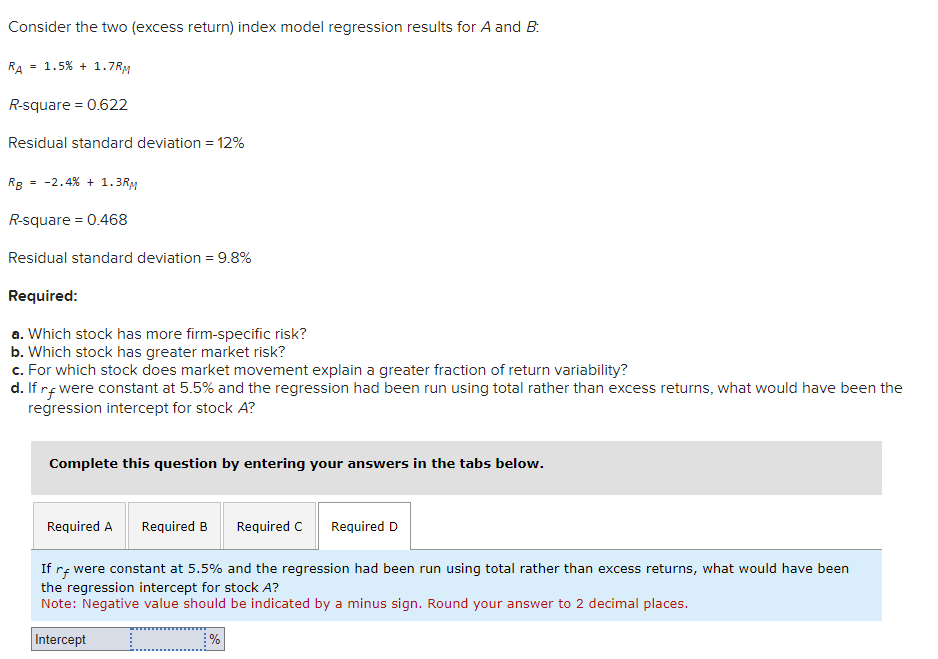Consider the two (excess return) index model regression results for A and B. RA = 1.5% + 1.7RM R-square = 0.622 Residual standard deviation = 12% RB = -2.4 % +1.3RM R-square=0.468 Residual standard deviation = 9.8% Required: a. Which stock has more firm-specific risk? b. Which stock has greater market risk? c. For which stock does market movement explain a greater fraction of return variability? d. If rf were constant at 5.5% and the regression had been run using total rather than excess returns, what would have been the regression intercept for stock A? Complete this question by entering your answers in the tabs below. Required A Required B Required C Required D If rf were constant at 5.5% and the regression had been run using total rather than excess returns, what would have been the regression intercept for stock A? Note: Negative value should be indicated by a minus sign. Round your answer to 2 decimal places. Intercept %
Consider the two (excess return) index model regression results for A and B. RA = 1.5% + 1.7RM R-square = 0.622 Residual standard deviation = 12% RB = -2.4 % +1.3RM R-square=0.468 Residual standard deviation = 9.8% Required: a. Which stock has more firm-specific risk? b. Which stock has greater market risk? c. For which stock does market movement explain a greater fraction of return variability? d. If rf were constant at 5.5% and the regression had been run using total rather than excess returns, what would have been the regression intercept for stock A? Complete this question by entering your answers in the tabs below. Required A Required B Required C Required D If rf were constant at 5.5% and the regression had been run using total rather than excess returns, what would have been the regression intercept for stock A? Note: Negative value should be indicated by a minus sign. Round your answer to 2 decimal places. Intercept %
Chapter8: Analysis Of Risk And Return
Section: Chapter Questions
Problem 6P
Related questions
Question

Transcribed Image Text:Consider the two (excess return) index model regression results for A and B.
RA
= 1.5% + 1.7RM
R-square = 0.622
Residual standard deviation = 12%
RB
= -2.4 % +1.3RM
R-square=0.468
Residual standard deviation = 9.8%
Required:
a. Which stock has more firm-specific risk?
b. Which stock has greater market risk?
c. For which stock does market movement explain a greater fraction of return variability?
d. If rf were constant at 5.5% and the regression had been run using total rather than excess returns, what would have been the
regression intercept for stock A?
Complete this question by entering your answers in the tabs below.
Required A Required B Required C Required D
If rf were constant at 5.5% and the regression had been run using total rather than excess returns, what would have been
the regression intercept for stock A?
Note: Negative value should be indicated by a minus sign. Round your answer to 2 decimal places.
Intercept
%
Expert Solution
This question has been solved!
Explore an expertly crafted, step-by-step solution for a thorough understanding of key concepts.
This is a popular solution!
Trending now
This is a popular solution!
Step by step
Solved in 2 steps

Recommended textbooks for you

EBK CONTEMPORARY FINANCIAL MANAGEMENT
Finance
ISBN:
9781337514835
Author:
MOYER
Publisher:
CENGAGE LEARNING - CONSIGNMENT

Intermediate Financial Management (MindTap Course…
Finance
ISBN:
9781337395083
Author:
Eugene F. Brigham, Phillip R. Daves
Publisher:
Cengage Learning


EBK CONTEMPORARY FINANCIAL MANAGEMENT
Finance
ISBN:
9781337514835
Author:
MOYER
Publisher:
CENGAGE LEARNING - CONSIGNMENT

Intermediate Financial Management (MindTap Course…
Finance
ISBN:
9781337395083
Author:
Eugene F. Brigham, Phillip R. Daves
Publisher:
Cengage Learning

